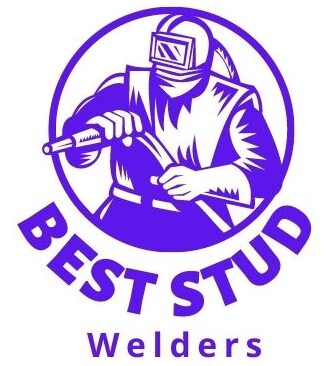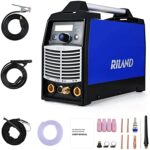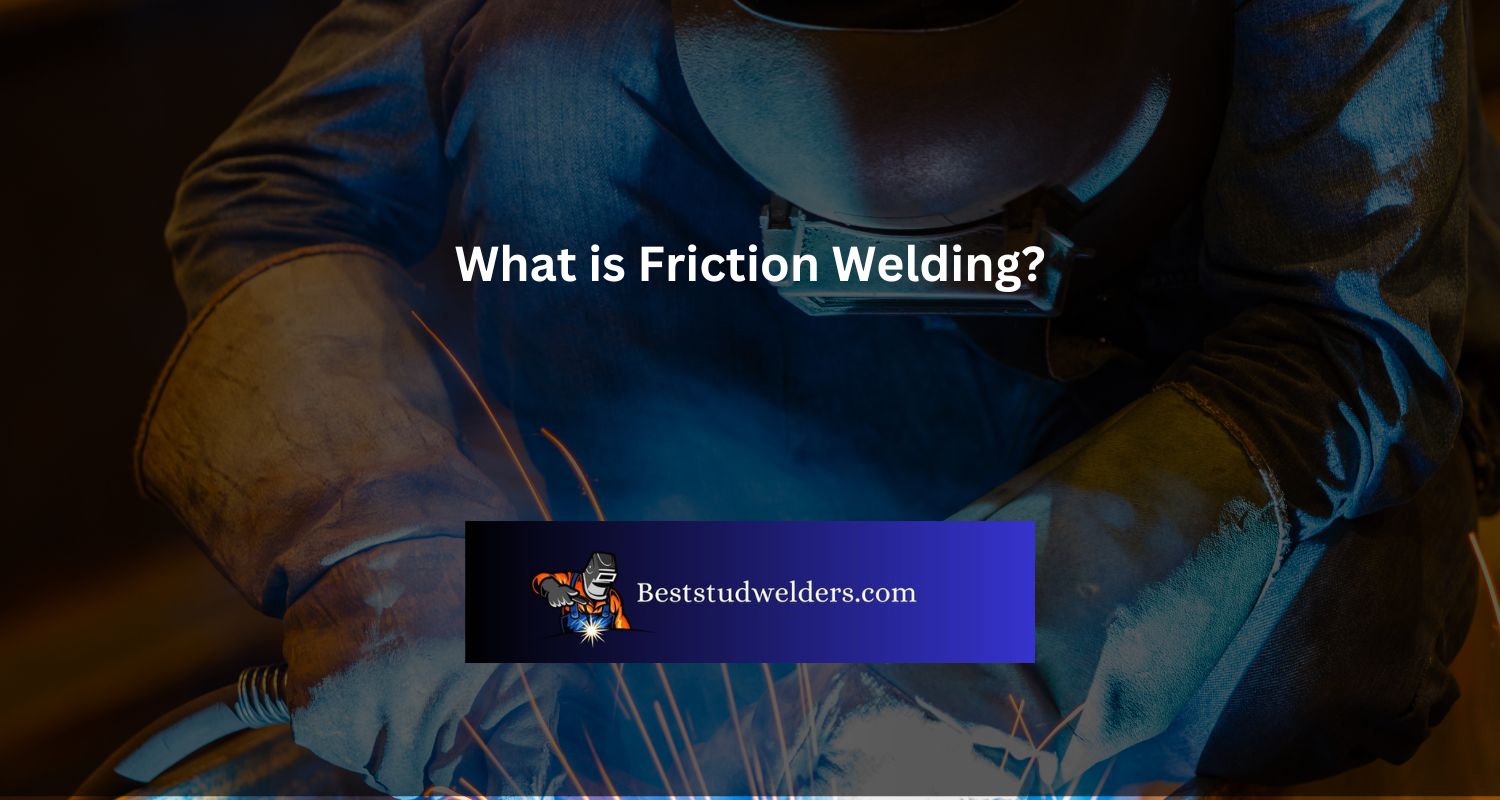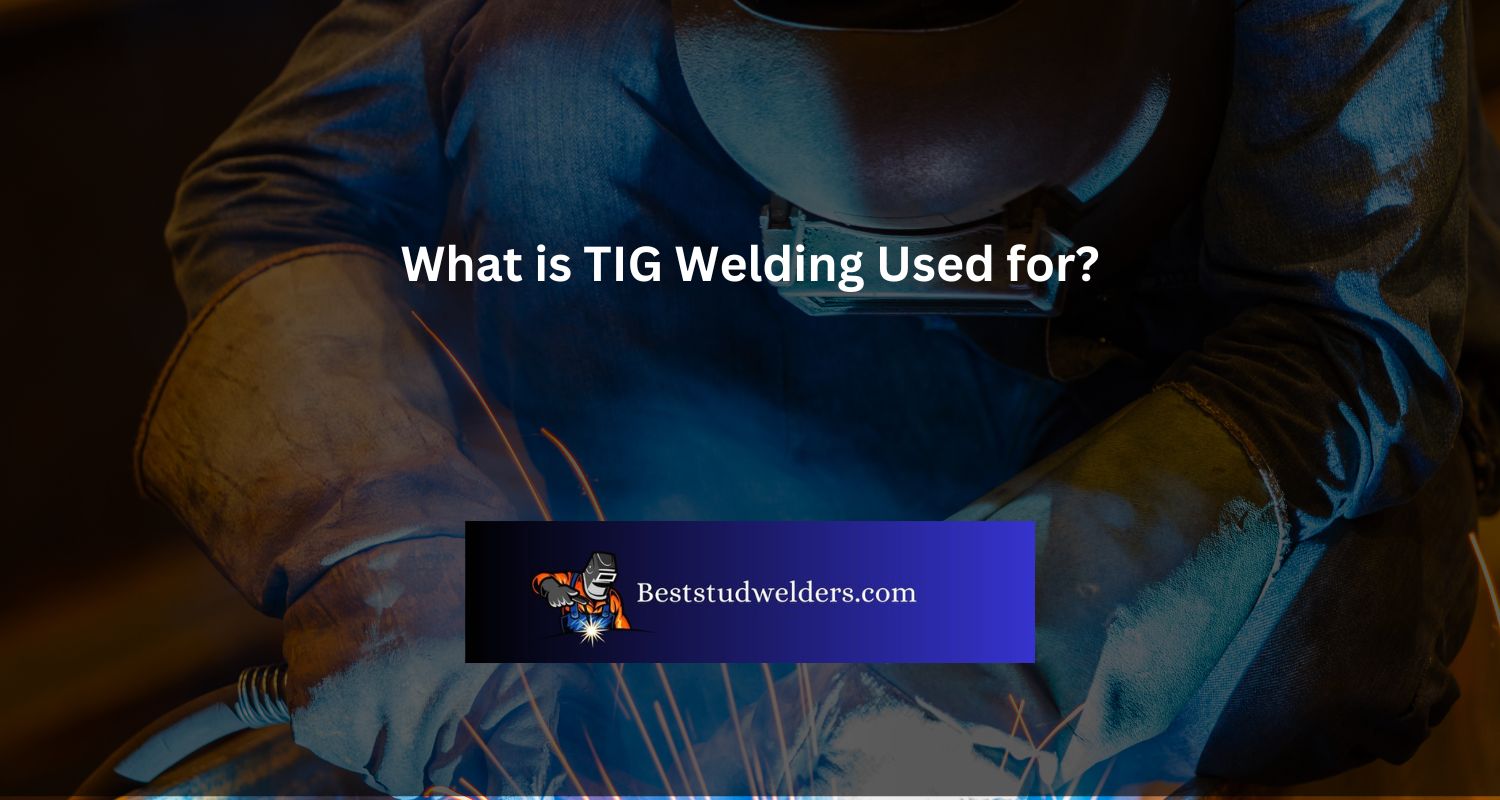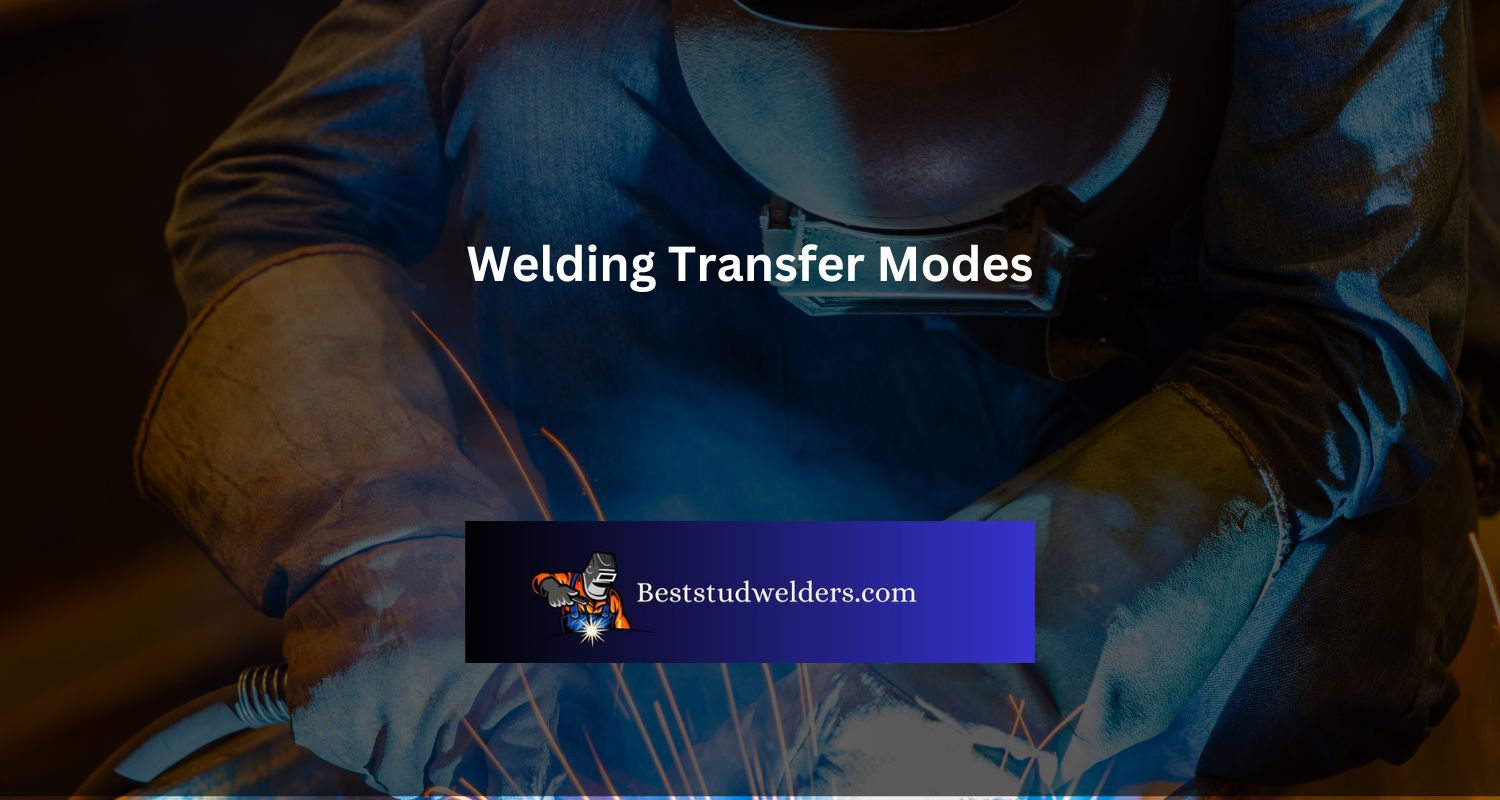Whether you’re a professional welder, metal fabrication enthusiast, or just getting started in welding and metalworking the stud welder is an essential tool for many projects.
Chances are you’ve seen them used on TV shows and movies to weld projects together and rightly so, because it’s one of the most versatile tools available for working with metal.
But what exactly is a stud welder? How does it work? And how can it help you create amazing projects?
In this blog post, we’ll answer all these questions and more as we go over everything there is to know about the stud welding process!
What is a Stud Welder?
A stud welder is a tool that uses electrical current and heat to bond a metal stud or fastener to a surface. The process involves melting the end of the stud with an electric arc, and then pressing it against the base material until it solidifies. This method creates a strong, permanent connection that is often used in construction, shipbuilding, and automotive industries.
| Column 1: | Column 2: | Column 3: |
| Type: | Application: | Benefits: |
| CDA/ARC Welding (Capacitor Discharge Arc): | – Low voltage – Rapid process – Used for thin materials – Can be used on painted and coated surfaces | – High bonding strength. – Consistent quality with no distortion of material. |
| DH/Short Cycle Stud Welding (Drawn Arc) | – Greater penetration on thicker materials. – Good on bigger diameter studs. – High speed application due to process automation. – Ideal for working temperatures up to around 1500F. | Absorbs distortions and tensions during welding. Bonds even large stresses evenly across construction site materials thanks to its alternating load-sharing concept. |
Stud welders come in various types with unique features that distinguish them from one another. They are highly efficient and provide a permanent solution that can withstand harsh conditions. Additionally, the stud welding process is an easy-to-use method that allows operators to weld without removing coatings or paint.
The history of stud welding dates back to World War II when it was used in shipbuilding and tank construction. It gained popularity after the war, especially in the automotive industry, where it proved useful in joining metal parts. Today, it remains one of the most popular methods of attaching fasteners to metal surfaces.
Get ready to be shocked (welded), as we reveal the electrifying process behind stud welding!
How Does a Stud Welder Work?
To understand the fundamentals of stud welding with different types of stud welding methods, you need to know how a stud welder works. A stud welder uses high-temperature to bond a metal stud to a base metal. Here, we will explain the science and technology behind stud welding. Additionally, we will briefly introduce the two different types of stud welding methods.
Understanding the Fundamentals of Stud Welding
To comprehend the basics of stud welding, it is essential to understand the working principles of a stud welder.
| Term | Description |
| Stud Welding | A process of joining metal fasteners to base metals without using additional bolts or screws. |
| Stud Welder | An inclusive machine that uses two methods – capacitor discharge (CD) and drawn arc (DA) welding for fastening studs on metal surfaces. |
| CD Welding | The process in which an electric current passes through the stud and heating it. Then, the molten tip is brought in contact with the surface with pressure to produce a smooth and strong bond. |
| DA Welding | The principle method in which power supply creates an arc between the stud and workpiece. It melts both parts, which unit as they cool down. |
It’s worth noting that various materials can be welded, including aluminum, titanium, steel, and brass.
Furthermore, it’s crucial to recognize that choosing an appropriate welder is essential. Countless models are available on the market for specific uses; hence research is needed.
In essence, understanding how a stud welder functions not only enhances safety but also increases efficiency when performing complex tasks.
Don’t miss out on embracing modern technology by investing in a quality stud welder today!
Get ready to stud-y up on the various ways to weld studs – it’s like a metal version of Tinder for welding!
.jpg)
Different Types of Stud Welding Methods
Stud welding is a process used to join metal studs or bolt-like fasteners to a base metal surface. There are several types of techniques available for this process.
A table below shows different types of stud welding methods with appropriate description and examples.
| Types of Stud Welding Methods | Description | Examples |
|---|---|---|
| Drawn Arc Stud Welding | An arc between the stud and workpiece creates heat, which melts the end of the stud and fuses it with the workpiece. | Industrial projects, construction sites |
| Capacitor Discharge (CD) Stud Welding | A rapid discharge of stored energy from capacitors through a weld stud creates a high-temperature arc that melts and welds the fastener to the base material. | Aircraft construction, shipbuilding |
| Short Cycle Stud Welding | A combination of drawn arc welding and capacitor discharge welding is employed in this method. It uses a timer to control how long an electric current passes through a stud relative to how long it is held in place against a mother plate. | Construction industry |
| Resin Compound Stud Welding | In this process, specially designed fasteners are secured using resin-based compounds without requiring any heat or electricity. The bond strength is achieved by curing the resin materials in ambient conditions or by heating them. | Electrical applications |
It’s worth noting that using these techniques requires trained personnel and specialized equipment.
Stud welding technology has been around since World War II, where it was developed to enable speedy assembly on ships for wartime use.
Stud welding: when you need a fastener that’s not going anywhere, unless you’re using a jackhammer.
Advantages of Stud Welding
To understand the benefits of stud welding, delve into the advantages it provides. Cost-effective and time-saving procedure, provides robust and long-lasting welds, and enhances the aesthetic appeal of the welded product are the sub-sections that will be explored.
Cost-Effective and Time-Saving Procedure
Unprecedented advantages of using stud welding technique include quickness and economical. The process eliminates the need for drilling holes, tapping, gluing, and other time-consuming practices that increase labor costs. As a result, it reduces production time considerably while simultaneously saving money.
Stud welding shaves off a significant amount of time by providing both heated studs and a base material without any adjustments to sizes or shapes required. Additionally, no secondary action is necessary with this method as it completes both securing the material and finishing at the same time. Its speediness allows for higher productivity as tasks complete rapidly leading to quicker turnaround times.
Despite its simplicity and speed, stud welding can carry out complex projects efficiently. It guarantees secure fastenings of diverse types of materials regardless of their thickness or shape precisely. Moreover, Stud welding is an ideal choice for NDT (non-destructive testing) applications that demand high standards of quality and safety.
Supposedly invented during World War II by German engineers who frequently used arc welders before realizing to fuse heating by electric arcs onto specially crafted nails attached by establishing contact physically between them directly with the attachment point on large steel plates to prevent them from warping under high heat exposure, thus giving birth to what we know today as stud welding.
With stud welding, you’ll create welds that could outlast your marriage (assuming you’re not a Hollywood celebrity).
Provides Robust and Long-Lasting Welds
Stud welding guarantees enduring and resilient joints which are essential in industrial settings. Here are six advantages of using this method:
- It creates a highly resilient bond that resists exposure to vibrations, torsion, and shear.
- Stud welding is applicable to a wide range of metals, including aluminum, stainless steel, and titanium.
- By eliminating potential contaminants like fluxes and fillers, it delivers clean welds with no slag or spatter.
- Maintenance expenses are low because cracked or damaged studs can be easily replaced without harming the parent material.
- This technique is especially well-suited for thin-walled items such as pipes having a thickness less than 3mm.
- Unlike other types of welding techniques, stud welding rarely calls for back-office labor.
Additionally, surplus benefits of stud welding involve improved productivity and better yield rates due to shorter cycle times and automated equipment. Inclusively speaking, increased process flexibility and adaptability also remain high points in favor of the stud welding method.
As such, if you’re looking to strengthen welds while cutting down on costs related to upkeep and plate replacement labor charges in structural engineering applications then investing in a stud-welding system could be a wise decision.
Stud welding: Giving your product the ‘studly’ aesthetic it deserves.
Enhances the Aesthetic Appeal of the Welded Product
The welding process plays a crucial role in the overall appearance of a product. Welding techniques can lend an enhanced aesthetic appeal, improving both its function and visual appeal.
Stud welding, for instance, is exceptionally useful in enhancing the external appearance of welded products. It creates clean and smooth surfaces that lend a sleek finish to the final product. With no visible weld bead marks, it offers improved consistency to the design, making it more visually appealing.
Apart from visual enhancements, stud welding also provides functional advantages like improved structural integrity and security measures. Its high-quality joints also resist corrosion, making it ideal for products used in harsh environments.
A simple suggestion to enhance the aesthetic appeal further would be customizing stud heads based on decorative preferences or color schemes. This approach will effectively increase brand awareness as well by unmistakably conveying the company’s logo colors or a particular signature hue scheme attached to its branding strategy.
Stud welding: Because getting attached has never been so easy.
Applications of Stud Welding
To understand various applications of stud welding with focus on the automobile industry, construction and manufacturing industry, and aerospace and defense industry, delve into this section of the article on stud welding. This section explores the key areas where stud welding is used and provides a brief insight into each sub-section without going into detail.
Automobile Industry
To apply the technique of Stud Welding in the Automobile Manufacturing Industry has numerous economic and practical advantages. It is a process by which small-sized metal objects like pins, screws or nails are welded onto significant parts of the automobile, increasing strength, durability, and precision of the product. This process finds its applications in various fields such as aerospace, defense manufacturing and construction industry along with the automobile sector.
| Advantages | Significant Aspects | |
|---|---|---|
| 1 | Increased Speed | Improved Productivity |
| 2 | Reduced Cost | Enhanced Safety |
| 3 | Better Quality | Precision Engineering |
Moreover, Stud Welding increases automation levels in the manufacturing processes of automobiles along with consistency. The highly skilled professionals operating the Stud Welding systems ensure that each weld is perfect to meet any specific design requirements.
Pro Tip: Always remember to Properly Clean the Metal Surface which will be used for welding purposes to achieve accurate results in terms of weld strength and longevity.
If you’re in the construction and manufacturing industry, forget about breaking a leg. With stud welding, you can break anything!
Construction and Manufacturing Industry
Stud welding has numerous applications in the sector involving construction and manufacturing. It is extensively used to join metallic components swiftly and safely, even in challenging locations. The strong bonds that studs create support structural reliability as well as enhance durability under harsh conditions and increase resistance against corrosion.
Stud welding facilitates welded stud connections that can endure extremely high temperatures and pressures, making it an ideal method for various applications like bridge building, erecting large industrial fabrications, steel fabrication, manufacturing of boilers and pressure vessels, shipbuilding, constructing sports facilities like stadiums or arenas.
Furthermore, stud welding is a quick process with minimal clean-up and does not leave behind any debris which makes this method environmentally friendly. Industries currently benefiting from Stud welding include automotive manufacturers such as cars, trucks, or buses among others.
Pro Tip: Stud welds should always be inspected by ultrasonic testing methods before they are put to use to ensure quality assurance.
Why bother with missiles when you can just stud weld your enemies to the ground? The aerospace and defense industry better watch out for this game changer.
Aerospace and Defense Industry
The application of stud welding in the Aerospace and Defense sector has significant benefits due to its ability to connect two metals with excellent joint strength, repeatability, and minimal deformation.
The following table shows the application and usage of stud welding in the Aerospace and Defense sector:
| Application | Usage |
|---|---|
| Manufacturing of Aircraft | Stud welding plays a significant role in manufacturing aircraft parts like airframes, wings, landing gears, and engine mounts. |
| Defense Equipment | Stud welding is used to join aluminum alloys for military vehicles such as armored personnel carriers, tanks, and missile systems. |
Stud welding technology is an efficient way of connecting two metals accurately. The use of this technology for manufacturing aircraft helps improve production processes and ensure uniform quality across different parts. In addition to that, it helps reduce the weight of an aircraft while maintaining its strength by using thinner materials.
Recently, a major aerospace company was struggling with heavy maintenance costs due to fatigue cracking in critical structural components. However, after implementing stud welding technology during the fabrication process of key components, they were able to eliminate these issues and save millions of dollars in maintenance costs annually.
Finding the right stud welder is like finding a needle in a haystack, except the needle is a machine and you’re not a farmer.
Choosing the Right Stud Welder for your Needs
To choose the right stud welder for your needs with Factors to Consider When Purchasing a Stud Welder and Maintenance Tips for Efficient Performance as solution briefly.
Factors to Consider When Purchasing a Stud Welder
When looking to acquire a stud welder, there are important factors you should consider before making your purchase. Here are some things to keep in mind:
Factors to Consider When Purchasing a Stud Welder:
| Category | Details |
|---|---|
| Type of Welding | Arc or Capacitor Discharge (CD) |
| Current and Voltage Range | Select the one that is suitable for your needs |
| Portability/Size | Consider where you will be using it, and if it will require moving from place to place |
| Ease of Use | Check the operator’s manual, training requirements, and whether the equipment requires calibration or maintenance |
In addition, when choosing a stud welder, it is important to think about the underlying materials used in the process. For example, welding studs made from different materials may require varying settings for current and voltage.
One user once shared their experience with selecting a stud welder based solely on price. While it was cheaper initially, over time, they spent more money on repairs than they would have if they had invested in quality equipment from the start. Therefore, it is essential to research stud welders before purchasing them – this can save you time and money in the long run. Because treating your stud welder like a neglected houseplant is a surefire way to end up with a disappointing performance.
Maintenance Tips for Efficient Performance
To ensure optimal performance of your stud welder, implementing effective strategies for maintenance is crucial. Here are some tips that may come in handy:
- Regularly inspect your stud welder’s cables and connections, ensuring they are free from debris and damage.
- Clean the welding tip after every use to remove any residue or buildup.
- Ensure that all moving parts like the chuck, armature, and solenoid plunger are well lubricated to reduce friction.
- Perform routine checks on the coolant level and keep it filled as per guidelines specified by the manufacturer.
In addition to these tips, try to avoid exposing your stud welder to extreme temperatures or humidity levels. Proper storage when not in use can also improve its longevity.
To ensure efficient performance of your stud welder for years down the line, it’s essential that you form good maintenance habits early on. These simple steps will make a significant difference in preventing breakdowns and prolonging its lifespan.
When it comes to stud welders, choosing the right one can mean the difference between success and a shocking result.
Conclusion on Stud Welders and their Benefits
Stud Welders’ Significance and Benefits are far-reaching in various industrial settings. They effortlessly join metals by electrically bonding studs to metal surfaces, increasing efficiency, and saving cost. A wide range of professional welders and fabricators understand the strengths of the stud welder in joining light to heavy gauge metals at high speeds without compromising results.
Stud Welding can be used on varying materials, such as aluminum, copper, brass alloys supplanting traditional methods such as screws or adhesives. It holds parts together firmly, providing excellent corrosion resistance without altering or damaging the integrity of the material.
One significant advantage is that it takes considerably less time to complete joints compared with conventional welding practices. This makes it ideal for high-volume production projects that require fast turnaround times without sacrificing quality or precision.
Moreover, several industries like automotive, aerospace, construction rely heavily on this versatile technology due to its lack of waste products than traditional welding methods which generate noxious gases harmful to both humans and the environment.
In a real-life story, a Snapper Productions factory was struggling with mechanical fasteners that were causing their motors to malfunction. The manager replaced the fasteners with stud welds from ProWeld’s Stud Welder. This replacement significantly boosted manufacturing productivity and allowed them to supply orders in advance.
Frequently Asked Questions
What is a stud welder?
A stud welder is a tool used to weld a metal stud, typically with a threaded end, onto a metal surface.
How does a stud welder work?
A stud welder uses an electrical charge to create an arc between the metal stud and the metal surface. The heat from the arc melts the end of the stud and the surface of the material, creating a bond as they cool and solidify.
What are the advantages of using a stud welder?
Stud welding is a fast and efficient method for attaching metal studs to a surface, as it can be done without drilling or tapping. It also results in a strong, durable bond that can withstand heavy loads and is resistant to vibration and corrosion.
What types of metals can be used with a stud welder?
A stud welder is typically used with metals such as steel, stainless steel, aluminum, and brass.
What are some common applications for stud welding?
Stud welding is commonly used in construction and manufacturing for attaching metal studs to concrete, steel structures, and sheet metal. It is also used in automotive and aerospace industries for securing components to metal frames and panels.
What safety precautions should be taken when using a stud welder?
As with any welding process, proper safety equipment such as welding gloves, eye protection, and a welding hood should be worn. The area should also be well-ventilated and free of flammable materials, and the welder should be properly trained in the operation of the equipment.
Paul Dixon is a certified welder with a wealth of experience in welding and related technologies. He started his career as an apprenticeship in welding, where he learned the ropes and acquired extensive skills in the craft.
Over the years, Paul has continued to sharpen his expertise, earning him top-rated welding certification. He remains one of the most outstanding welders in the industry.
